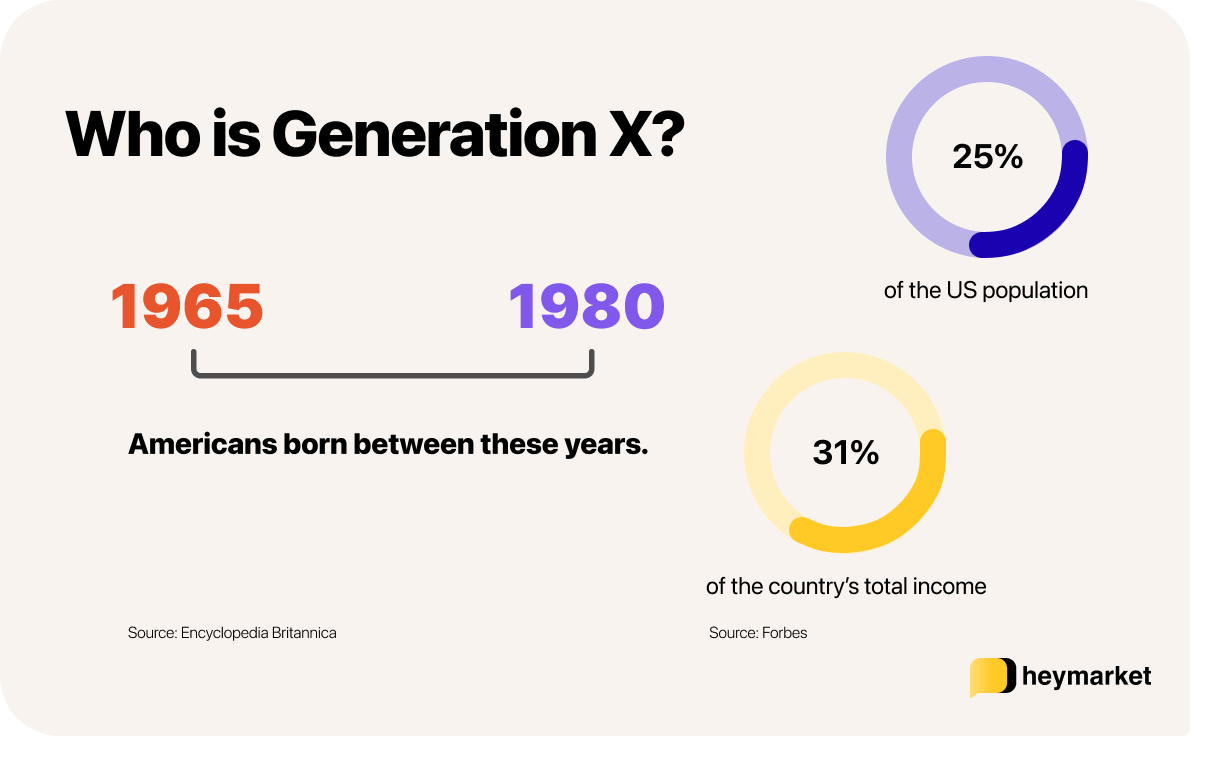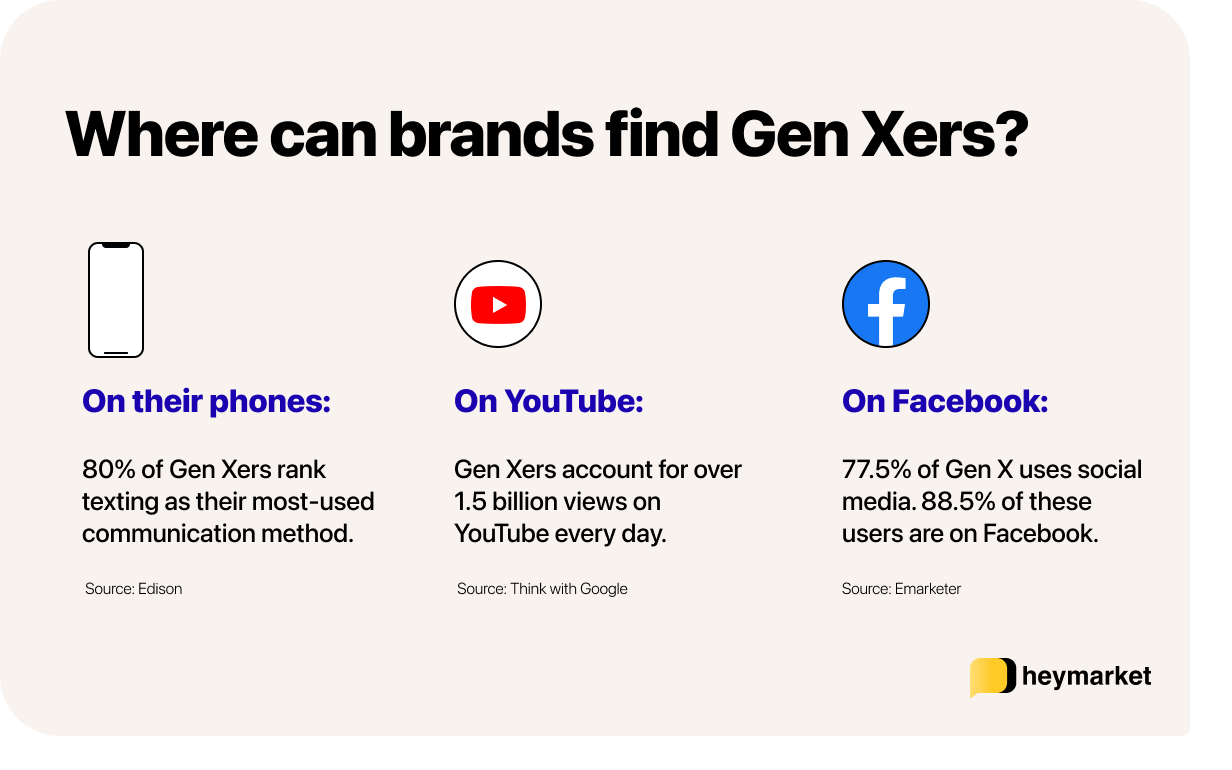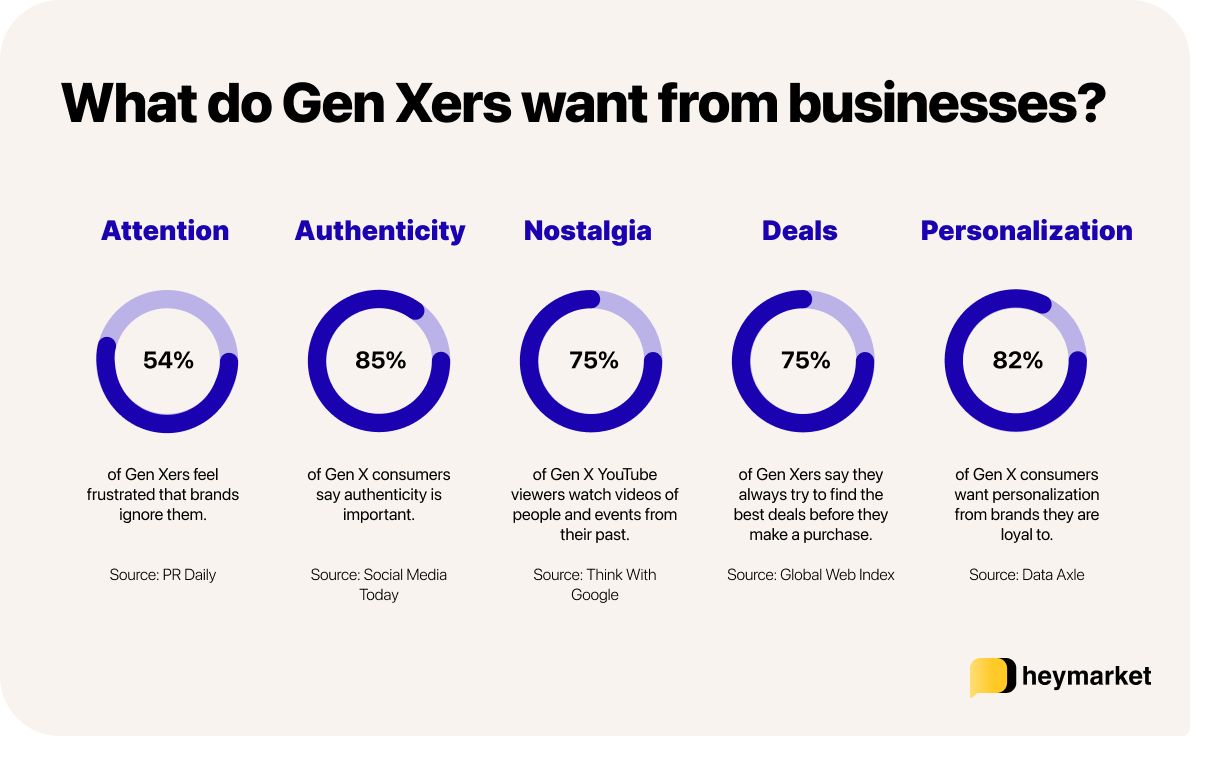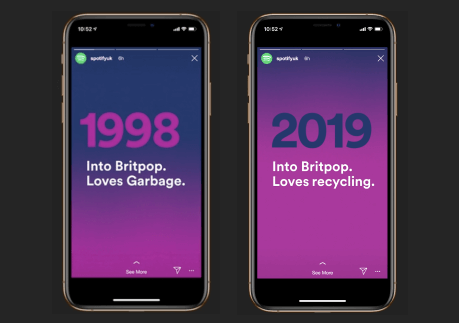While baby boomers, millennials, and now Gen Z’s “zoomers” were dominating the headlines, Generation X has quietly come of age. Now, in the prime of their careers and their prime purchasing years, their presence demands businesses’ attention.
But businesses can only reap the benefits of reaching this too-often-forgotten generation if they learn what sets them apart from the rest. Get to know this complex cohort of Americans, discover what makes them tick as consumers, and learn how your business can best connect with them in this complete guide to marketing to Generation X.

Learn how to reach Gen Xers on their preferred channels with SMS marketing.
Learn moreWhat is Generation X?
Sandwiched between the Baby Boomers and Millennial generations, Generation X is composed of Americans born between 1965 and 1980. Two decades after the fading of the Seattle grunge scene that briefly defined the so-called “MTV Generation,” Gen Xers have now reached middle age. In their 40s and 50s, many Gen Xers have long since settled down, begun to raise families, and increasingly taken on positions of power.
At times, it can seem like this position between two more famous generations of Americans is its most notable feature. The Baby Boomer generation became a symbol of post-World War II optimism, while millennials have drawn attention for their digital literacy and differing priorities. Meanwhile, Gen X has been referred to by some as the “Forgotten Generation.” Elsewhere, they’ve been called the “New Lost Generation,” “sandwich generation” and even American culture’s “neglected middle child.” However, today’s businesses can only neglect this cohort of consumers at their own peril.
Thanks to their professional maturity, Gen Xers now command above-average wealth and a sway in the marketplace that cannot be overlooked. Despite being the smallest generation, Gen Xers possess an outsized purchasing power. Its members make up just 25% of the US population but make up about 31% of the country’s total income.

Still, the economic picture for Gen Xers is anything but simple. Although they earn more than any other generation, the average Gen Xer also holds the most debt, as they take on big-ticket purchases like houses and cars.
Use These 10 Strategies to Market to Generation X
Today’s businesses will naturally want to tap into this generation’s sizable purchasing power. However, to actually connect with this generation of Americans and earn their business, brands will require a nuanced understanding of Generation X’s unique needs and behaviors.
Use these 10 strategies for marketing to Gen X to reach Gen Xers in the right place and with the right message.
1. Acknowledge Generation X in your marketing
The first step to getting your brand on the minds of Gen Xers? Start by acknowledging them.
The widespread perception that Generation X is often overlooked in favor of their generational neighbors isn’t just talk. Gen Xers themselves—a majority of them, in fact—feel frustrated that brands tend to ignore them.
This attention gap creates a clear opportunity for businesses trying to reach the valuable market of Generation X customers. Stand out from the crowd by making a direct appeal to Gen Xers in your next campaign. Acknowledge the real-life events that Gen Xers are experiencing as they reach their late-forties, fifties, and sixties. They may have a newly empty nest, or they may be welcoming their older kids back to live at home. They may have reached the peak of their career with a new promotion, made a late career change to follow their passion, or even planned an early retirement. Any of Gen Xers’ latest milestones that can be tied to your business’s message and mission are fair game—and this audience wants to hear from you.
2. Appeal to Gen Xers’ growing nostalgia
You don’t necessarily have to address their present to get Gen Xers’ attention, though. You may just need to hearken back to their past. A study of Gen Xers’ behavior on YouTube found that 75% used the platform to watch videos related to past people and events. For brands looking for ways to directly appeal to Gen Xers in their marketing, nostalgia can be a powerful tool.
And the good news is there’s no shortage of historic moments and cultural shifts to point to when targeting Gen Xers. The very oldest Gen Xers sat in front of TV sets when man first set foot on the moon, while many of the youngest did the same to see the fall of the Berlin Wall. They’ve witnessed the rise of the personal computer, the internet, and mobile phones (and might have fretted over the Y2K bug). Generation X has seen the world radically change, and they’ve changed right along with it—something businesses can underline in their marketing.
3. Stay authentic in your messaging
Of course, that’s not to say that your business can serve up just any nostalgic message and expect it to land with your Gen X audience. Although many Gen Xers may be enjoying the security and comforts of middle age, that doesn’t mean they’ve lost their trademark skepticism.
85% of Gen X consumers say authenticity is important to them when deciding which brands to support. So, when you target this generation, your message needs to come from a genuine place.
4. Emphasize security and offer peace of mind
When marketing to Gen X, it’s important to keep in mind that a lot of the time, you’re not marketing to a whole generation—you’re marketing to individuals with lives. Many Gen Xers are raising families. They’re also often juggling jobs, mortgages, and all the stresses that come with managing middle age. As a result, many Gen X consumers are in search of stability and are often worried about their financial security.
Overcome their trademark skepticism and build trust with messaging that communicates the peace of mind your product can bring. In your marketing, you can relate to Gen Xers by acknowledging their challenges, emphasizing security, and assuring them that your business can be relied upon. One tactic that can boost your reliability and ease concerns is presenting real-life reviews and customer stories. Better yet, present your business not as a provider but as a partner Gen Xers can rely on.
5. You still need to win on price
For as much as brands need to be conscious of their messaging when marketing to Generation X, they still need to offer their customers a great value. Despite their tendency to be higher earners, three in four Gen Xers say they always try to find the best deals before they make a purchase. Even with their skepticism and need for authenticity, Gen Xers remain the most likely of all generations to value price over brand name.
6. Find Gen Xers on their mobile devices
Gen Xers may have grown up without smartphones and social media, but by now they’re just as tech savvy as their millennial counterparts. Despite their busy professional and family lives, Gen Xers still manage to spend three hours per day—or about 16.5% of their waking lives—on their smartphones. Strategic outreach on mobile channels is critical for today’s brands.
For these early adopters of the internet, email has long been a staple of their personal and professional lives. Today, it continues to be a reliable marketing channel for businesses. However, the tide might have finally shifted here toward text messaging. According to a recent study, 80% of Gen Xers now rank texting as their most-used communication method, followed by email. Gen X use texting even more than notoriously text-friendly millennials.
As Gen Xers juggle the many responsibilities of their busy middle-age lives, texts offer the convenience of instant (yet asynchronous) communication. Today’s brands can tap into this increased comfort and familiarity with the channel using an SMS marketing platform capable of delivering the personalized messaging that 82% of Gen X consumers prefer.

7. Find them on social media (in the right places)
If a text doesn’t do the trick, then social media is also a safe bet for being seen by Generation X consumers—so long as you choose the right networks.
According to eMarketer, 77.5% of Gen X uses social media. However, their usage is much narrower than younger audiences. So, while Gen X hasn’t exactly flocked to TikTok, an incredible 88.5% of Gen X social media users can be found on Facebook. Meanwhile, 46% of them use Instagram and 25% use Twitter.
8. Provide plenty of online resources
Although texting and social media offer productive outreach channels for marketers, brands also need to ensure that Gen X shoppers can easily discover and evaluate their brands organically.
On their way to making a well-informed purchase, Gen X consumers thoroughly research products and brands. To engage these potential customers and help guide them towards a successful purchase, business should prioritize the creation of easily discoverable, search-optimized content. With robust owned content that answers common questions about products and use cases, establishes authority, and builds trust, businesses can create a friction-free path to purchase for Gen X consumers who like to learn as much as they can before they buy.
9. Don’t neglect traditional advertising
Among current generations, Gen X occupies a unique position: its members have adopted today’s tech about as well and as widely as any other generation, but they’re still able to remember a world without all of today’s digital touchpoints. Their shopping habits and marketing preferences reflect this same mix of the digital and the physical.
While plenty accustomed to, and skilled at, shopping and engaging with brands on their devices, Gen Xers continue to check the mail for coupons and deals. And even though a majority of Gen X are daily users of YouTube, tens of millions of Gen Xers continue to be faithful viewers of traditional TV.
The lesson for today’s brands? When marketing to Gen X, omnichannel may be the way to go. Focus on crafting an authentic message that speaks to Gen Xers’ needs and values. Then make sure that all channels—across both digital and physical media—work in tandem to provide a consistent, unified experience.
10. Once you land a Gen X customer, don’t let them go
No matter where you reach Gen X consumers, one thing’s for sure: they will repay excellent products and experiences with their loyalty. In one study, Gen Xers were only second to Baby Boomers in their tendency to remain loyal to the brands they love best: two in three members of America’s so-called “sandwich generation” said that once they found a product they like, they tend to become repeat customers.
Businesses can tap into this tendency and drive maximum value by creating a loyalty program that offers rewards for repeat purchases, including discounts, premium service, free shipping, and more.
Combined with the other insights and lessons of this guide, businesses can not only reach more Generation X consumers than ever before—but retain them, too.

Top Examples of Gen X Marketing in Action
It’s one thing to talk about successfully targeting Generation X; it’s another to actually accomplish it. These examples of Gen X marketing pull it off in style, while touching on a variety of the strategies covered above.
AARP offers security and support in future-focused campaign
For the oldest Gen Xers, retirement is less than a decade away, but only 54% feel on track for a secure retirement. Apparently in response to this trend, AARP crafted the “Wise Friend and Fierce Defender” campaign that offers the security and peace of mind that Gen Xers crave.
In the campaign’s opening ad spot, a middle-aged Gen X skateboarder rolls through the park as the voiceover positions AARP as the friend that can help people make sound decisions about their health and finances. In addition to emphasizing security, the campaign drives its point home with a direct appeal to Gen Xers beginning to ponder retirement: “The younger you are, the more you need AARP.”
Spotify taps into ’80s and ’90s nostalgia
Rather than look forward, Spotify targeted the Gen X and elder millennial audience in the UK with its 2019 “Listen Like You Used To” campaign. In well-placed traditional ads as well as digital videos, the viral campaign contrasted what music-lovers were up to between 1979 and 1999 versus today using references to classic songs. One of several excellent ad variants reads: “1979: London Calling. 2019: Conference Calling.”

Domino’s goes shot for shot with “Ferris Bueller” and brings back an old face
In a stateside campaign, Domino’s went a similar route, playing up nostalgia with a remake of the final scene from a Gen X favorite, 1986’s “Ferris Bueller’s Day Off.” Only instead of trying to beat his parents home while playing hooky, the ad’s “Ferris” races through backyards to grab his fresh pizzas. Just two years later, Domino’s doubled down on the yesteryear yearnings by bringing back the Noid, its popular mascot from the 1980s.
HelloFresh displays deals where Gen X can see them
Not all Gen X-friendly campaigns require big budgets and flashy videos. This HelloFresh ad checks off several of the boxes we covered above with ease. For starters, it finds Gen Xers on their social network of choice. It also succinctly offers price-conscious Gen Xers a deal and establishes authority with a comparison of its number of 5-star reviews.
Wrapping Up
Although until now, many businesses may have overlooked Generation X, the potential value they can offer as loyal customers should have every organization rushing to the drawing board and crafting a new campaign just for them. Luckily, with the insights, examples, and strategies for marketing to Generation X we’ve detailed above, your own business will have a running start. Keep the top takeaways from our guide handy with the help of this visual here, and you’ll be connecting with the dynamic members of America’s sandwich generation in no time.





